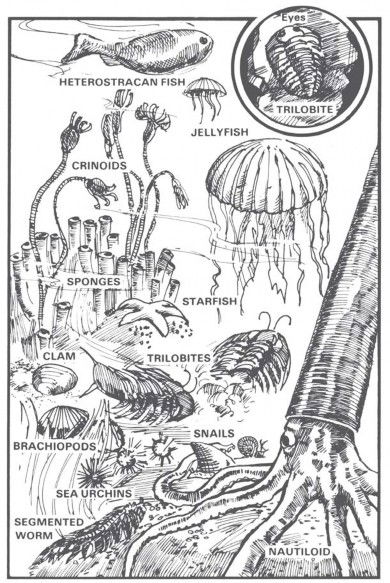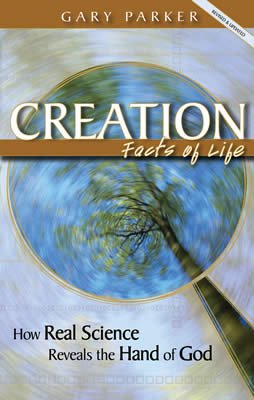
3.3 Invertebrates: Animals Without Backbones
The Fossil Evidence
Take a look at Figure 23. If you live near the seashore or like to visit marine aquaria, I’m sure most of the animals there are quite familiar to you. There are some jellyfish floating in the background. On the bottom, you can find sea urchins and sea lilies, members of the starfish group; a couple of snails; sponges; lampshells; and members of the earthworm group. That large fellow stretched out along the right side is a nautiloid, a squid-like animal that is a member of the most complex group of invertebrate animals we know anything about (the cephalopod mollusks). The nautiloid belongs to the group of animals that has an eye somewhat like ours, as I mentioned in the first chapter.

Figure 23. The “first” or simplest community to leave abundant fossils, the lower “Trilobite Seas” (Cambrian system), contains almost all the major groups of sea life, including the most complex invertebrates, the nautiloids, and the highly complex trilobites (inset above). Darwin called the fossil evidence “perhaps the most obvious and serious objection to the theory” of evolution.
What does this illustration show? A picture of present-day sea life off the Florida coast or around some tropical island? No, not at all. It pictures not sea life today, but the “first” or simplest community of plants and animals to leave abundant fossil remains. This illustration shows life in the so-called “Age of Trilobites” (what I’ll later call the “Zone of Trilobites”), the Cambrian geologic system.
Trilobites, by the way, are fascinating creatures. Many trilobites, such as the one pictured in the inset in Figure 23, had extremely complex eyes. When I take students snorkeling and scuba diving, I have to warn them that organisms and objects underwater appear closer and larger than they really are (so that big, nearby shark is really smaller and farther away!). Some trilobites didn’t have that problem. They had double-lens systems that made the correction for underwater vision, sort of “hand-crafted prescription face masks,” masterpieces of design.
Trilobites belong to the same complex group that insects do (the arthropods). Unfortunately, no trilobites are known to be alive today. Trilobites are very famous as fossils, however, and may have a lot to tell us about how life began. As my paleontology professor, an evolutionist, said: “Never let anyone tell you a trilobite is a simple animal.”
Suppose we could scuba dive in the ocean back when the trilobites were alive. If we compared life in the trilobite seas with what we see in the oceans today, what would we say? “Look at all the new forms of life, the increased variety, and greater complexity!” No, that’s not what we would say at all. Rather, we might say, “What happened? Where did everything go? What happened to all the trilobites? Where are all the lampshells? There used to be several thousand species of lampshells (brachiopods); now only a handful are left!” We might also wonder what happened to the great nautiloids, so much bigger and more varied in the Cambrian seas than those today. Today, the only shelled squid we have is the modest pearly nautilus.
Decline and even extinction, not evolution, is the rule when we compare fossil sea life with the sort of marine invertebrates we find living today. In fact, all major groups, except perhaps the groups including clams and snails, are represented by greater variety and more complex forms as fossils than today.
It’s hard to imagine how absolutely crushing this evidence is to evolution. Suppose, for example, that you had a burning desire to find out where snails came from. You search the fossil evidence all over the world, all the way back to the “beginning,” the “first” abundant fossils in Cambrian deposits, and, sure enough, snails come from snails. Where did the most complex of all the invertebrates, members of the squid and octopus group, the cephalopods, come from? Again, you search through all the fossil evidence, all the way back to the very “beginning,” and, sure enough, “squids” come from “squids.” In fact, the first “squids” (cephalopods), the nautiloids, are more impressive than most modern forms. Of course, trilobites seem only to come from trilobites. There’s no evidence they evolved from, or into, anything else.
In other words, you find snails and squids and trilobites as fossils; you don’t find “snids” and “squails” and “squailobites,” or some other in-between form or common ancestor. The “missing links” between these groups are still missing.
In fact, few scientists, if any, are still looking for fossil links between the major invertebrate groups. The reason is simple. All the groups appear as separate, distinct, diversified lines in the deepest fossil-rich deposits. Evolutionists are well aware of these facts, and several have admitted that this “explosion” of life in Cambrian (“lower trilobite”) rock seems to favor the concept of creation.
The sudden appearance of a multitude of complex and varied life forms at the very bottom of the fossil-rich portion of the geologic column is now routinely called the Cambrian explosion. A far greater variety of basic body plans is present among Cambrian fossils than among life forms along Australia’s Great Barrier Reef, perhaps the richest life zone today! Evolutionists had expected life to begin with a few simple life forms thrown together by time, chance, and chemistry, and they had expected the variety and complexity of life to build gradually as natural selection culled the best from random mutational changes. Although it’s still taught, the Cambrian evidence renders this classic view flatly false!
To a creationist, Cambrian fossils are simply the descendants of the created (and corrupted) kinds first buried in the catastrophe of Noah’s flood. When I was a graduate student trying to decide between creation and evolution, the Cambrian fossil evidence made it very hard to believe in evolution, very easy to accept what the Bible says about creation, corruption, catastrophe, and Christ.
Evolutionists have come up with just about every explanation for the Cambrian explosion except the biblical model. Francis Crick, the Nobel laureate who argued chemical evolution was impossible on earth and must have occurred on another planet, followed up by suggesting that the “seeds of life” arrived on earth in some sort of rocket ship that accidentally or deliberately hit the earth, giving life an explosive extra-terrestrial “jump start.”
Many evolutionists still cling to their traditional belief that life did start slowly and gradually on earth, but that the evidence rotted away since the early forms lacked the hard parts that make the best fossils. The Cambrian explosion, then, is simply an explosion of hard parts occurring simultaneously in many different animal groups. Besides being an appeal to faith rather than an inference from science, the “hard part hypothesis” requires multiple mathematical miracles for the repeated origin of gene sets for hard parts by time-and-chance in different lines. The view also contradicts the most reasonable of all evolutionary assumptions, that complex features, like hard parts, have descended by variation from a common ancestor in which the feature originated by just one “miracle,” not many miracles after the lines diverged.
The hard-part hypothesis also contradicts the fossil evidence. Although rare, soft parts do preserve, and, although rare, Precambrian fossils are found. What does the Precambrian soft-part evidence tell us about life before the Cambrian deposits were laid down?
Evolutionists used to say that they would have found the ancestors of Cambrian life there if only the evidence hadn’t rotted or been destroyed by heat in the rocks. That “excuse” no longer works. Although most Precambrian rock is the igneous and metamorphic type unsuitable for fossil preservation, we have now discovered great stretches of Precambrian sedimentary rocks that could and should have preserved soft parts and the common ancestors of the diverse and complex Cambrian life—if any such evolutionary ancestors existed.
Actually, Precambrian fossils strongly support the creation concept. My wife, Mary, and I have found soft-bodied jellyfish and members of the earthworm group (annelids) in the famous Ediacara beds of South Australia. What lessons do we learn from the “oldest” animal fossils? Once a jellyfish, always a jellyfish; once an “earthworm” (annelid), always an “earthworm.” Most people think of segmented worms as fish bait, but to a biologist, they are marvelously complex. The “lowly” earthworm, for example, has five “hearts,” a two-hemisphere brain, and a multi-organ digestive system. It looks like Precambrian animal fossils are telling us the same thing about the origin of life that Cambrian fossils are: Living things look as if they were created well designed to multiply after their kinds and to fill the earth with stupendous and soul-satisfying variety!
Creation is also supported by our ability to use the same criteria to classify both living plants and animals and those found as fossils. Even among extinct types, we don’t find “in-between forms,” or forms that are any harder to classify (when the fossil evidence is complete enough) than plants and animals living today.
Most people just assume that fossils and evolution go hand in hand. Some people even seem to think that “believing in” fossils is almost the same as “believing in” evolution. We’ve been so thoroughly indoctrinated with “educational” materials and entertainment touting evolution, that it’s hard even to think that fossils argue so strongly against evolution and for the biblical outline of history.
Could I be right about that? Is there anyone else who thinks that the fossils argue against evolution? Yes, indeed . . . Charles Darwin, for one. That’s right, Charles Darwin, the father of the modern concept of evolution. Darwin thought that the fossil evidence was “perhaps the most obvious and serious objection which can be urged against the theory [of evolution].” Why? Because he knew some of the same things that we know about fossils.
Darwin’s chapter on the fossil evidence was titled “On the Imperfection of the Geologic Record.” In that chapter, he dealt with “the sudden appearance” of groups of fossils in the lowest known fossil-bearing strata (the Cambrian). When it came to intermediate links (those types of fossils supposed to show how one kind of life evolved into others), Darwin wrote the following:
. . . intermediate links? Geology assuredly does not reveal any such finely graduated organic chain, and this is perhaps the most obvious and serious objection which can be urged against the theory [of evolution] (emphasis added).
So Darwin was faced with a conflict. Theory (evolution) and facts (fossils) didn’t agree. Which was he going to throw out, the facts or the theory? Darwin chose to throw out the facts. Normally, of course, a scientist doesn’t do that, but Darwin had reason, or at least hope, for doing so. He blamed the conflict between fact and theory on “the imperfection of the geologic record.” In his time, the science of paleontology (fossil study) was just getting under way. He hoped that as new fossil evidence was unearthed around the world, the “missing links” would be found to support his theory.
It’s now well over a century since Darwin made that statement, and we’ve unearthed thousands of tons of fossils from all over the world. What does all this massive amount of evidence show? Have we found the “missing links” required to support the theory of evolution, or have we merely unearthed further evidence of variation within the created kinds?
David Raup reviewed the evidence for us when he was curator of the famous Field Museum of Natural History in Chicago. That museum houses 20 percent of all fossil species known, so Raup was in a position to speak with considerable knowledge about the fossil evidence. The title of his article in the Field Museum Bulletin is “Conflicts Between Darwin and Paleontology,”1 and the thrust is repeated and expanded in a second article, “Geology and Creationism.”2
Raup starts by saying that “most people assume that fossils provide a very important part of the general argument made in favor of Darwinian interpretations of the history of life. Unfortunately, this is not strictly true.” He then quotes the same passage from Darwin that I did, and points out that Darwin was “embarrassed” by the fossil evidence. He goes on to say that we now have a rich body of fossil knowledge, so that we can no longer blame the conflict between evolutionary theory and the fossil facts on the “imperfection of the geologic record.” He mentions also, as I did, that Darwin expected those gaps in his theory, those missing links, to be unearthed by future discoveries. Then Raup summarizes those discoveries:
Well, we are now about 120 years after Darwin, and knowledge of the fossil record has been greatly expanded. . . . Ironically, we have even fewer examples of evolutionary transition than we had in Darwin’s time. By this I mean that some of the classic cases of Darwinian change in the fossil record, such as the evolution of the horse in North America, have had to be discarded or modified as a result of more detailed information (emphasis added).
What a statement! Darwin said that the fossil evidence was perhaps the most obvious and serious objection against his theory. Raup is saying that 120 years of research have made the case for Darwinian evolution even worse. Raup says we have “even fewer examples” now, since new evidence has forced evolutionists to change their minds about examples, like the horse, that were once used. (For details, see the master’s thesis by Walter Barnhart3 or my discussion of fossil horses in Fossils: Key to the Present4 and/or The Fossil Book,5 and see Figure 27, page 175.)
Raup’s words still eloquently summarize the fossil evidence. Except for a couple of flawed exceptions we’ll discuss later, those of us who do creation-evolution debates and/or speak for university audiences still encounter the same old candidates for “missing links” used in the late 1800s and early 1900s—if our evolutionist opponents even try to bring up fossil evidence at all.
Raup goes on to say that “we still have a record which does show change, but one that can hardly be looked upon as the most reasonable consequence of natural selection.” In comparing fossil forms with modern forms, we do see change all right, but it’s not the kind of change associated with evolution by natural selection. It’s simply variation within the created kinds, plus decline and even extinction, reflecting corruption and catastrophe.
Raup is still an evolutionist, but he’s beginning to argue for “survival of the luckiest,” instead of “survival of the fittest.” Condemning with faint praise, he says, “Natural selection as a process is okay. We are also pretty sure that it goes on in nature, although good examples are surprisingly rare.” Genetic studies suggest that mutation-selection could not lead to evolutionary change; the fossil evidence seems to confirm that it did not.
Raup then tries to argue that “optimal engineering design” is the best evidence of evolution—exactly the same kind of evidence that geneticist Lewontin conceded as the best evidence of creation! One of the reasons evolution continues to survive is that paleontologists believe geneticists have the real evidence, and geneticists believe that paleontologists have the evidence, and so on around the various specialties within biology, each one passing the buck for evidence to the next one. Since professionals in different disciplines rarely talk with one another about such matters, the myth of overwhelming support for evolution continues.
After he bemoaned the repeated failures of evolution to come to grips with the fossil evidence, paleontologist Niles Eldredge6 lamented that the only alternative is “special creation.” As we have seen, the fossils of invertebrates, the most abundant by far of all fossils, do offer strong support for the concept of creation, specifically the biblical concepts of creation, corruption, catastrophe, Christ. But let’s look now at fossil evidence from other groups.
Creation: Facts of Life
Dr. Parker, a leading creation scientist and former AiG speaker, presents the classic arguments for evolution used in public schools, universities, and the media, and refutes them in an entertaining and easy-to-read style. A must for students and teachers alike! This is a great book to give to a non-Christian as a witnessing tool.
Read OnlineFootnotes
- David Raup, “Conflicts Between Darwin and Paleontology,” Field Museum of Natural History Bulletin (January 1979).
- David Raup, “Geology and Creationism,” Field Museum of Natural History Bulletin (March 1983).
- Walter R. Barnhart, A Critical Evaluation of the Phylogeny of the Horse, Master’s thesis (Santee, CA: Institute for Creation Research, 1987).
- Richard B. Bliss, Gary E. Parker, and Duane T. Gish, Fossils: Key to the Present, Two Models Creation-Evolution Series (Green Forest, AR: Master Books, 1980).
- Gary and Mary Parker, The Fossil Book (Green Forest, AR: Master Books, 2005).
- Niles Eldredge, as quoted in the Sunday Mail, Brisbane, Australia (September 14, 1986).
Recommended Resources

Answers in Genesis is an apologetics ministry, dedicated to helping Christians defend their faith and proclaim the good news of Jesus Christ.
- Customer Service 800.778.3390
- Available Monday–Friday | 9 AM–5 PM ET
- © 2025 Answers in Genesis



